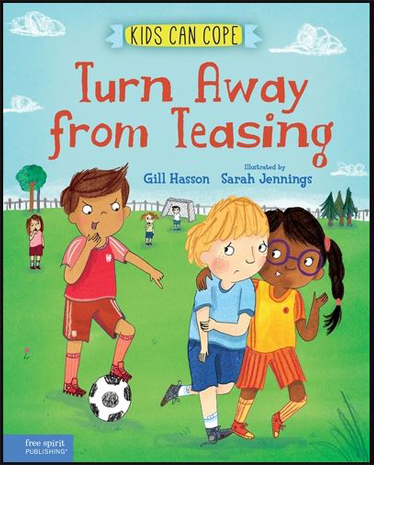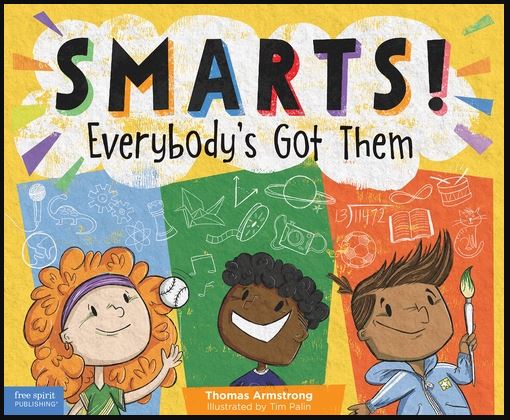Related Products
For Parents
Related Teacher Tools Takeout Items
Pace of Learning & Keeping Up in the Classroom
As you are probably aware, 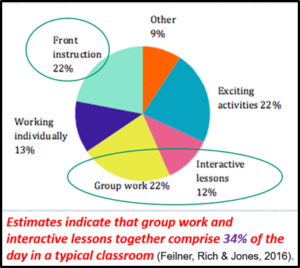 education has changed with teacher lecture becoming less prominent as an educational practice. Typically, new information is presented in a lecture format supplemented by reading material, until students build surface knowledge of the topic. Interaction activities such as classroom discussion, small group work and partner problem-solving are used to solidify surface knowledge and to move students to a deeper level of understanding1. Therefore, how well students are able to participate in the classroom setting truly impacts their move toward deeper understanding.
education has changed with teacher lecture becoming less prominent as an educational practice. Typically, new information is presented in a lecture format supplemented by reading material, until students build surface knowledge of the topic. Interaction activities such as classroom discussion, small group work and partner problem-solving are used to solidify surface knowledge and to move students to a deeper level of understanding1. Therefore, how well students are able to participate in the classroom setting truly impacts their move toward deeper understanding.
This article focuses on the ‘unseen’ challenges that children with hearing loss often experience when trying to keep up in the regular education setting.v
On the way to deeper understanding: For students with hearing loss, keeping pace in moving to a deeper level of understanding can be very challenging. A favorite study was reported by Christie Yoshinaga-Itano in 20102 and considered language learning 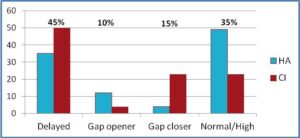 of students with hearing loss from age 4 to age 7. There were 4 categories of results: children who were delayed at age 4 and still language delayed at age 7 (45%), those who had language within the normal range and 4 and still did at 7 (35%), those who actually closed their language learning gap from age 4 to age 7 (15%), and 10% of the children had language within the normal range at age 4, but due to lack of access and/or appropriate instructional support, developed a learning gap by age 7. Clearly, it cannot be assumed that just because a student has ‘okay’ language at school entry that they will be able to keep up with class expectations across the academic years.
of students with hearing loss from age 4 to age 7. There were 4 categories of results: children who were delayed at age 4 and still language delayed at age 7 (45%), those who had language within the normal range and 4 and still did at 7 (35%), those who actually closed their language learning gap from age 4 to age 7 (15%), and 10% of the children had language within the normal range at age 4, but due to lack of access and/or appropriate instructional support, developed a learning gap by age 7. Clearly, it cannot be assumed that just because a student has ‘okay’ language at school entry that they will be able to keep up with class expectations across the academic years.
Background, or world knowledge is necessary to build surface level understanding of a specific topic. Prior knowledge is an excellent predictor of performance. Our students tend to have ‘Swiss cheese language’ with unpredictable knowledge gaps in vocabulary and concepts. They also are often limited in the number of attributes they use to describe objects or concepts, further contributing to their gaps and limited world knowledge. Imagine learning about the conquistadors if you lacked knowledge of geography, discoveries of early explorers, and that there are different countries and they may desire different things.
Examples of Student Misunderstanding of Teacher Instruction3
 “The Indians were dying because of the drought and the famine.” Student asked: “Why were they dying if they had all that fish?” Lack of discrimination between d/t and f/s. Student thought the words ‘trout’ and ‘salmon’ were said.
“The Indians were dying because of the drought and the famine.” Student asked: “Why were they dying if they had all that fish?” Lack of discrimination between d/t and f/s. Student thought the words ‘trout’ and ‘salmon’ were said.
Book Chicka Chicka Boom Boom was being read aloud by the teacher: “A told B and B told C, I’ll meet you at the top of the coconut tree.” At the end of the lesson, when asked to retell what was said the student replied, “Today we learned about cocoon trees.” Thereby demonstrating that the vocabulary ‘coconut tree’ needed to be pretaught and connected to knowledge of other trees before the teacher read the story.
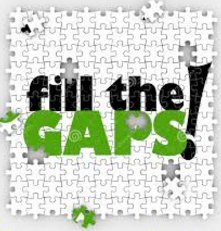
Filling the gaps. We can expect that surface learning will take longer for students with hearing loss than their typically hearing peers. Students who have a less complete understanding of surface level information are not going to benefit to the same degree, or at the same rate, during interactive activities meant to move them to deeper understanding. “Closing the language gaps” is not just something that is a nice extra touch to provide to our students if there is a teacher of the deaf available; it is necessary for deeper learning. Add to this the fact that reduced precision listening ability often delays literacy skill development and slows reading fluency. Just teaching vocabulary, without sufficient phonological awareness, will not develop the reading fluency the students need for comprehension at the pace of peers. Filling in the gaps in prior knowledge is necessary if a child is to be able to develop the surface learning that is prerequisite to developing deeper understanding. Without this surface learning, a deeper understanding is not possible.

Conversational inequalities. Research4 has indicated that during one-on-one conversations in a quiet setting, students who are hard of hearing have conversational skills equivalent to their hearing peers. This includes skills for initiating a conversation, maintaining a dialogue over several turns, shifting the topic, and terminating the conversation. In a typical mainstream classroom, there are many choices for communication partners along with background noise, reverberation, and listening at distances beyond 3 feet that interfere with speech perception of students who are hard of hearing. Students with hearing loss make fewer overall communication attempts than their hearing peers. They also often seem unaware when their peers tried to initiate conversation and did not attempt to maintain the conversation. When they attempt to maintain the conversation they generally use one-to two-word phrases to maintain the communication and do not add new information. The research found that in a 1:1 conversation, 75% of the maintenance attempts by children with hearing loss were appropriate compared to 100% for hearing peers. They frequently tried to maintain the conversation by bringing up a topic that was unrelated to the conversation. In other words, they were not aware enough of the content of the conversation to contribute information, so they brought up a new topic.
Thus, educational practices to move to deeper understanding by way of interaction with peers is often very challenging for students with hearing loss. As can be inferred by the research, in quiet settings listening by students who are hard of hearing often approaches or equals peers. Therefore, it is the acoustic access inequality in the classroom that results in conversational challenges for students with hearing loss. This provides a powerful argument for the use of hearing assistance technology (HAT) that will improve perception of peer voices in 1:1 or group settings.
Challenges repairing breakdowns. Another aspect of conversation relates to what a person does when they do not fully understand. One study5 found that  persons with hearing loss were able to cue into changes in topic but had much more difficulty when a shift in topic was made during the conversation. The research findings can be summarized as, the more predictable the conversation, the fewer the likely breakdowns. If a student is sitting with a group who maintains their focus on the problem-solving task, the level of understanding is likely much higher than if the student was in a group who wandered off topic repeatedly. The teacher needs to be aware of this issue when pairing the student with different partners or groups. Moving to a quieter area for discussion will not ensure full participation by the student with hearing loss, but will make participation easier and more likely. Including him or her in a group that sticks to the topic will heighten the value of the exercise for the learner with hearing loss.
persons with hearing loss were able to cue into changes in topic but had much more difficulty when a shift in topic was made during the conversation. The research findings can be summarized as, the more predictable the conversation, the fewer the likely breakdowns. If a student is sitting with a group who maintains their focus on the problem-solving task, the level of understanding is likely much higher than if the student was in a group who wandered off topic repeatedly. The teacher needs to be aware of this issue when pairing the student with different partners or groups. Moving to a quieter area for discussion will not ensure full participation by the student with hearing loss, but will make participation easier and more likely. Including him or her in a group that sticks to the topic will heighten the value of the exercise for the learner with hearing loss.
Keeping up in the classroom is a challenge for children with hearing loss due to access issues that interfere with understanding conversational communication and the gaps in knowledge resulting from decreased auditory access since infancy (or sign communication with limited language models since infancy). Filling the gaps of  vocabulary and phonological awareness is necessary for students to keep up with class expectations for developing surface learning. Access to classroom discussion and for all group activities is a prerequisite for deep learning to occur. Providing the appropriate access technology is a necessity to facilitate deeper learning to occur within the classroom. Selecting appropriate group partners and honing communication repair skills is also critical to students with hearing loss achieving at the same rate and to the same level as peers.
vocabulary and phonological awareness is necessary for students to keep up with class expectations for developing surface learning. Access to classroom discussion and for all group activities is a prerequisite for deep learning to occur. Providing the appropriate access technology is a necessity to facilitate deeper learning to occur within the classroom. Selecting appropriate group partners and honing communication repair skills is also critical to students with hearing loss achieving at the same rate and to the same level as peers.
References:
1. Fisher, Frey, Hattie (2016) Visible Learning for Literacy Grades K-12: Implementing the Practices that Work Best to Accelerate Student Learning. Corwin/SAGE, Thousand Oaks, California
2. Yoshinaga-Itano (2010). The longitudinal language learning of infants and children with hearing loss. ASHA Virtual EHDI Conference, October.
3. Meyer, Kym (8/17/2017). Wait – There’s a Student with Hearing Loss Coming into My Class? Webinar viewable at https://www.youtube.com/watch?v=r3ytOawiYuI&feature=youtu.be
4. Duncan (2001). Conversational skills of children with hearing loss and children with normal hearing in an integrated setting. The Volta Review, 101(4), 193-211.
5. Caissie (2002). Conversational topic shifting and its effect on communication breakdowns for individuals with hearing loss. The Volta Review, 102(2), 45-56
2017 © Karen L. Anderson, PhD, Late November Update, Supporting Success for Children with Hearing Loss http://successforkidswithhearingloss.com This information is not intended as legal advice.

